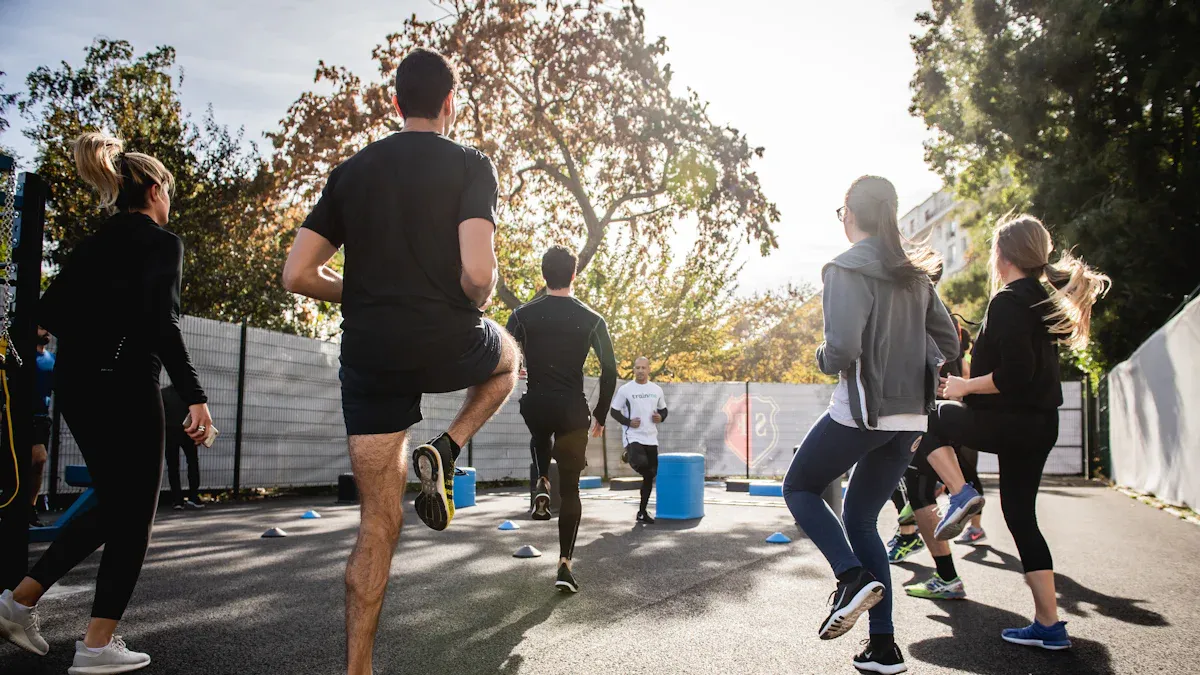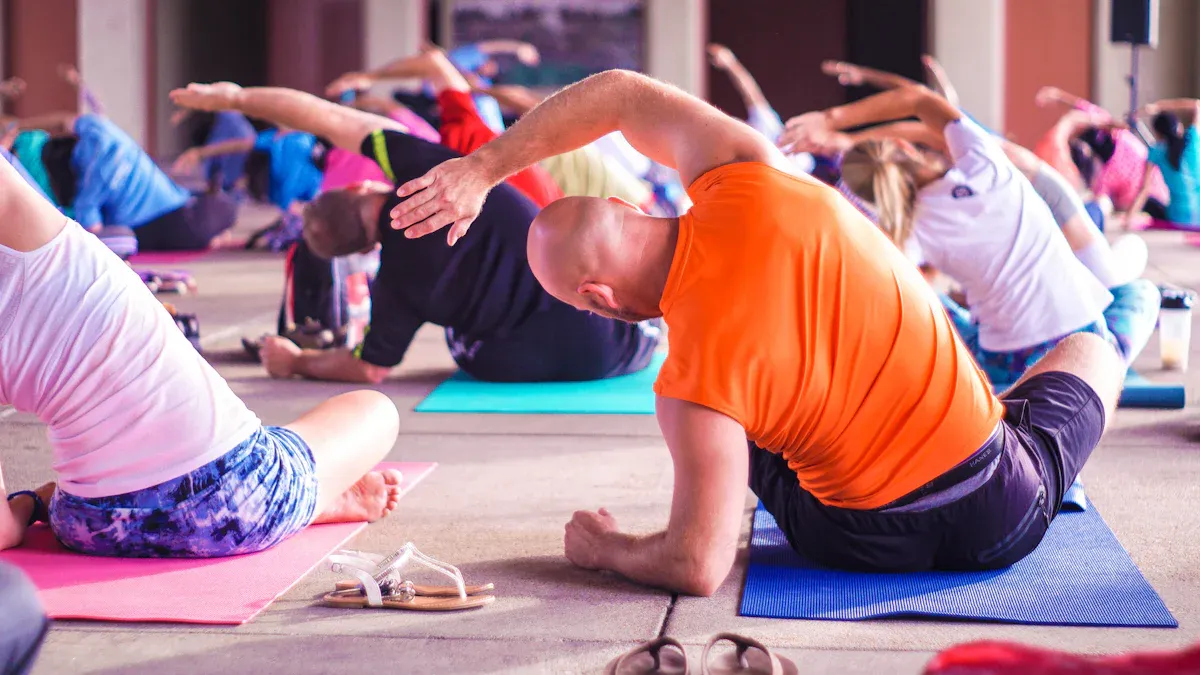Why Physical Activity is Key to Reducing Cancer Risk

You hold the power to protect your health through movement. Physical activity doesn’t just strengthen your body—it actively reduces your risk of cancer. Studies show that individuals who exercise regularly can lower their chances of developing cancers like lung, colorectal, and breast cancer. For example, a meta-analysis of 98 studies revealed that higher physical activity levels reduced cancer risk significantly, with active women experiencing up to a 21% lower risk of breast cancer. By staying active, you regulate hormones, reduce inflammation, and maintain a healthy weight, all of which are vital for cancer prevention. The importance of physical activity in preventing cancer cannot be overstated—it’s a simple yet transformative step toward a healthier future.
Key Takeaways
Being active often can cut your risk of some cancers, like breast and colon cancer, by 10% to 20%.
Moving your body helps balance hormones and lowers swelling, which are important to stop cancer.
Try to do 150 minutes of moderate exercise each week for the best health benefits.
Add fun activities to your schedule to stay excited and make exercise a regular part of your life.
Even short exercises, like walking for 10 minutes daily, can help your health and lower cancer risk.
The Importance of Physical Activity in Preventing Cancer

How Physical Activity Reduces Cancer Risk
Hormone regulation and its role in cancer prevention
Your body’s hormones play a crucial role in maintaining health, but imbalances can increase cancer risk. Regular physical activity helps regulate hormones like estrogen and insulin, which are linked to cancers such as breast and endometrial cancer. By staying active, you can lower these hormone levels, reducing your risk. A study from the American Cancer Society found that leisure-time physical activity significantly decreases the risk of 13 types of cancer, including breast and colon cancer. This highlights how exercise supports your body’s natural defenses against cancer.
The impact of reduced inflammation on cancer risk
Inflammation is another factor that contributes to cancer development. Chronic inflammation can damage cells and lead to mutations that cause cancer. Exercise reduces inflammation by improving circulation and supporting your immune system. A 2016 meta-analysis revealed that individuals with high physical activity levels experienced a 19% lower risk of colon cancer. This demonstrates how staying active can protect your body at a cellular level.
The Link Between Weight Management and Cancer
How exercise helps maintain a healthy weight
Maintaining a healthy weight is one of the most effective ways to reduce cancer risk. Physical activity burns calories, builds muscle, and boosts metabolism, helping you achieve and sustain a healthy weight. Research shows that individuals who exercise regularly have a significantly lower risk of cancers like colon and breast cancer. Even moderate activity, such as walking for 30 minutes a day, can make a difference.
The connection between obesity and cancer risk
Obesity increases the risk of several cancers, including liver, kidney, and esophageal cancer. Excess body fat produces hormones and inflammatory markers that promote cancer growth. Exercise combats this by reducing fat and improving overall body composition. A pooled analysis of over 1 million individuals found that leisure-time physical activity significantly reduced bladder cancer risk. By incorporating movement into your daily routine, you can take control of your health and lower your cancer risk.
How Much Exercise Do You Need for Cancer Prevention?
Recommended Physical Activity Guidelines
Aerobic exercise: Frequency and duration
Aerobic exercise is one of the most effective ways to reduce your cancer risk. Activities like walking, cycling, or swimming improve your heart rate and circulation, which help regulate hormones and reduce inflammation. Experts recommend at least 150 to 300 minutes of moderate-intensity aerobic exercise or 75 to 150 minutes of vigorous-intensity activity each week. For example, brisk walking for 30 minutes, five days a week, can make a significant difference. Studies show that individuals who engage in moderate exercise for 3–4 hours weekly experience a 10–20% lower cancer risk compared to those who remain sedentary.
Type of Exercise | Frequency |
|---|---|
Moderate aerobic activity | |
Strength training | 2 to 3 times a week |
General physical activity | At least 150 minutes moderate or 75 minutes vigorous per week |
Strength training: Benefits for cancer prevention
Strength training, such as lifting weights or using resistance bands, complements aerobic exercise by building muscle and improving metabolism. This type of exercise helps maintain a healthy weight, which is crucial for reducing cancer risk. The American Cancer Society suggests incorporating strength training 2–3 times per week. By adding these sessions to your routine, you can enhance your body’s ability to fight inflammation and regulate hormones, further lowering your cancer risk.
Types of Exercises to Include
Moderate vs. vigorous activity: What’s best for you?
Both moderate and vigorous activities offer cancer-preventive benefits, but the best choice depends on your fitness level and preferences. Moderate activities, like gardening or walking, are easier to sustain and still provide significant health benefits. Vigorous activities, such as running or high-intensity interval training (HIIT), burn more calories and may offer additional advantages for weight management. The key is to find a balance that works for you and keeps you consistent.
Examples of effective cancer-preventive exercises
Incorporating a variety of exercises into your routine can maximize your results. Some effective options include:
Walking or jogging: Great for cardiovascular health and weight management.
Swimming: A low-impact option that improves endurance and strength.
Yoga or Pilates: Helps reduce stress and improve flexibility.
Cycling: Boosts heart health and burns calories.
Research highlights the benefits of these activities. For instance, a meta-analysis of 38 cohort studies found that increased physical activity significantly lowers breast cancer risk. Similarly, studies show that higher exercise levels reduce the risk of colon and bladder cancers. By choosing activities you enjoy, you can stay motivated and protect your health.
Benefits of Exercise for Cancer Survivors

Improving Quality of Life
Reducing fatigue and enhancing energy levels
Exercise can be a game-changer for cancer survivors dealing with fatigue. Physical activity boosts your energy levels by improving blood flow and oxygen delivery to your muscles. A meta-analysis of 34 trials found that exercise significantly reduces cancer-related fatigue (CRF) while enhancing energy and overall quality of life. For example, colorectal cancer patients who engaged in 150 minutes of weekly activity reported an 18% higher quality of life score.
Supervised exercise programs, especially during or after treatment, have shown remarkable results. A review of 28 randomized controlled trials (RCTs) revealed modest improvements in CRF, while another meta-analysis of 18 RCTs highlighted statistically significant benefits for breast cancer patients. These findings emphasize how staying active can help you feel more energized and less fatigued, even during challenging times.
Tip: Start with light activities like walking or yoga to gradually build your stamina and reduce fatigue.
Supporting mental health and emotional well-being
Physical activity doesn’t just strengthen your body—it uplifts your mind. Exercise releases endorphins, the “feel-good” hormones, which help reduce stress, anxiety, and depression. Cancer survivors often face emotional challenges, but regular movement can provide a sense of control and positivity.
A structured exercise program can also improve your confidence and resilience. For instance, a study tracking survivors before and after an exercise program showed a 31% increase in participants meeting recommended activity levels. This improvement reflects not only physical gains but also enhanced mental well-being.
Measure | Before Program | After Program | Improvement |
|---|---|---|---|
Percentage of survivors meeting recommended activity levels | 29% | 60% | 31% increase |
Mean sit-to-stand repetitions | 12.3 | 14.3 | 2 repetitions |
Participant retention rate | N/A | 76% | N/A |
Lowering the Risk of Cancer Recurrence
Evidence supporting exercise for long-term recovery
Staying active after cancer treatment can significantly lower your risk of recurrence. Research from the Nurses’ Health Study found that breast cancer survivors who walked more than three hours weekly had lower recurrence rates and improved overall survival. Another study revealed that survivors exercising for over 2.5 hours per week reduced their risk of all-cause mortality by more than 60%.
Study Year | Population | Findings |
|---|---|---|
2005 | 2987 patients from Nurses’ Health Study | Women with breast cancer walking more than 3 hours a week had lower recurrence rates and greater overall survival. |
2008 | Breast cancer survivors | Patients exercising >2.5 hours/week post-diagnosis had >60% reduction in risk of all deaths compared to inactive patients. |
2019 | 25,563 breast cancer survivors | Most active survivors had 42% lower risk of death from any cause and 40% lower risk of death from breast cancer compared to least active. |
How physical activity aids in reducing recurrence risk
Exercise helps your body fight cancer recurrence by regulating hormones, reducing inflammation, and improving immune function. Physical activity lowers levels of insulin and estrogen, which are linked to cancer growth. It also strengthens your immune system, enabling it to detect and destroy abnormal cells more effectively.
By incorporating regular movement into your routine, you empower your body to stay strong and resilient. Whether it’s walking, swimming, or strength training, every step you take brings you closer to a healthier future.
Inspiration: Remember, every small effort counts. Consistency is the key to long-term recovery and well-being.
Practical Tips for Incorporating Physical Activity Into Your Life
Starting and Maintaining an Exercise Routine
Setting achievable goals for beginners
Starting small is the key to building a sustainable exercise routine. Set realistic goals that match your current fitness level. For example, aim for a 10-minute walk each day and gradually increase the duration as you feel more comfortable. Breaking larger goals into smaller, manageable steps can help you stay motivated.
Tip: Use a journal or app to track your progress. Seeing your improvements over time can boost your confidence and keep you on track.
Overcoming barriers to staying active
Life can get busy, but finding ways to overcome obstacles is essential. Identify common barriers, such as lack of time or motivation, and create solutions. For instance, schedule your workouts like appointments or combine exercise with daily tasks, like walking while making phone calls.
Participants in exercise referral schemes (ERS) have shown that making physical activity a priority can lead to long-term lifestyle changes.
These changes often inspire family members to adopt healthier habits, creating a ripple effect of wellness.
Making Exercise Enjoyable and Sustainable
Choosing activities you enjoy
Enjoyment is a powerful motivator. Choose activities that make you happy, whether it’s dancing, hiking, or swimming. Research shows that people who enjoy their workouts are more likely to stick with them. High-intensity interval training (HIIT) and other engaging exercises can also improve mood and reduce stress.
Note: The more you enjoy your routine, the easier it becomes to make exercise a regular part of your life.
Integrating movement into daily habits
Incorporating movement into your daily routine doesn’t have to be complicated. Take the stairs instead of the elevator, park farther away from your destination, or do light stretches while watching TV. Even household chores like gardening or cleaning can contribute to your activity levels.
Experts recommend engaging in any form of physical activity, from walking to cycling, to lower cancer risk.
Structured exercises like swimming or running can further enhance your fitness and overall health.
Staying Motivated and Accountable
Tracking progress and celebrating achievements
Tracking your progress can help you stay focused and motivated. Use a fitness tracker, app, or simple notebook to record your activities. Celebrate milestones, like completing a week of consistent exercise or reaching a new personal best. Small rewards, like treating yourself to a new workout outfit, can keep you inspired.
Building a support network for encouragement
Surround yourself with people who encourage your fitness journey. Join a local exercise group, participate in community programs, or invite friends and family to join you. Studies show that ongoing support is crucial for maintaining an active lifestyle. Community-based programs can provide professional guidance and help you stay consistent.
Inspiration: Remember, you’re not alone. A strong support system can make all the difference in achieving your goals.
Physical activity is a powerful ally in your fight against cancer. By staying active, you can regulate hormones, reduce inflammation, and maintain a healthy weight—all critical factors in cancer prevention. Research shows that consistent exercise reduces the risk of several cancers, including breast, colon, and bladder cancer, by 10%–20%.
Cancer Type | Relative Risk Reduction |
|---|---|
Breast | 10% - 20% |
Colon | 10% - 20% |
Bladder | 10% - 20% |
Start small and stay consistent. Even a brisk 30-minute walk can make a difference. Every step you take strengthens your body and protects your future.
Tip: Make movement a daily habit. Your health is worth it!
FAQ
How does physical activity lower cancer risk?
Exercise helps regulate hormones, reduce inflammation, and maintain a healthy weight. These factors play a key role in lowering your risk of developing cancer. Regular movement strengthens your immune system, enabling it to fight abnormal cells more effectively.
What types of exercise are best for cancer prevention?
Both aerobic and strength-training exercises are effective. Activities like walking, swimming, and cycling improve heart health, while strength training builds muscle and boosts metabolism. Choose activities you enjoy to stay consistent and motivated.
Can small amounts of exercise still make a difference?
Absolutely! Even 10–15 minutes of daily activity can benefit your health. Start small and gradually increase your duration. Every step you take contributes to reducing your cancer risk and improving your overall well-being.
Is exercise safe during cancer treatment?
Yes, but consult your doctor first. Light activities like walking or yoga can reduce fatigue and improve mood. Tailor your routine to your energy levels and physical condition for the best results.
How can I stay motivated to exercise regularly?
Set achievable goals and track your progress. Celebrate small milestones to stay inspired. Join a support group or exercise with friends to make the journey enjoyable and sustainable. Remember, consistency is key to long-term success.
Tip: Find an activity you love. It’s easier to stay active when you enjoy what you’re doing!
See Also
An In-Depth Overview of Various Cancer Types
Exploring Symptoms and Causes Associated With Anal Cancer
Key Information You Need About Carcinoid Tumors
